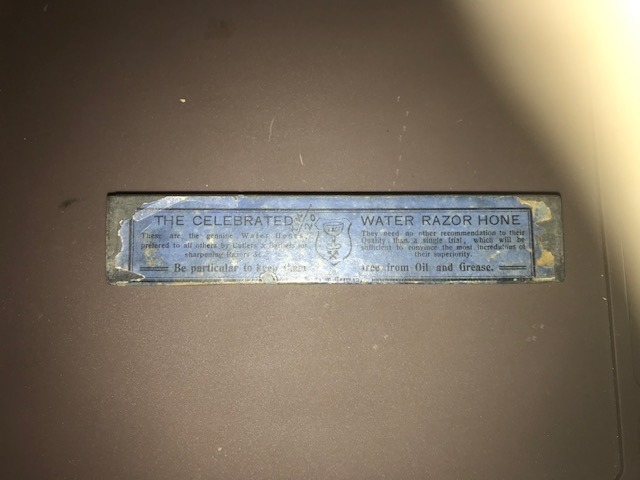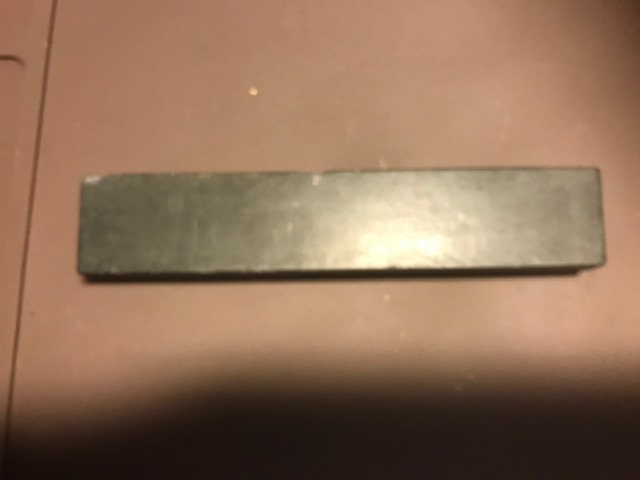Results 11 to 20 of 22
Thread: ebay score! Finally an Escher!
-
10-30-2020, 01:23 AM #11

I used a clear nail polish stuff called "hard as nails" that you can find at Walmart, etc.. I've used it on a couple stones in the past and it has worked great. I usually do two coats to make sure it's covered.
As for lapping, it went pretty smooth. I used some old worn down diamond hones from Harbor Freight...I think I have a 200, 300, 400, and 600 grit. After that, I smooth it out a bit with a Norton flattening stone and then a 1200 grit diamond plate from Best Sharpening Stones.com. Worked great and lapped pretty easily.Classic, traditional Barber and owner at Barber's Notch in Brigham City, Utah.
-
The Following User Says Thank You to Wxman2000 For This Useful Post:
Portsecurity (10-30-2020)
-
10-30-2020, 01:25 AM #12

I've tried it on a couple razors now and it is different. I've used coticule edges for years now and recently began looking for something that's still smooth, but just a touch more keen than the coticules provide. This stepped up the game, but I've also been experimenting with Arkansas stones lately, and I really love those edges. I do like the edges from it, but time will tell if I prefer the Escher or the Ark's.
Classic, traditional Barber and owner at Barber's Notch in Brigham City, Utah.
-
10-30-2020, 08:41 AM #13

From the picture that shows the stone wet, I would propose that is not a dark blue but a light blue layer. Same as the green stones also the blue layers exist in all color perculiarities. In the Escher classification light blue doesn't exist, the stones were sold as light green. One reason for that can be seen in the history of mining thuringian stones. During the first period, only yellow and green layers have been exploited, because they have been considered the best quality. Later also slightly blue layers were mined and sold, but also classified as "green". Because of high demand and export and the fact, that the green layers became harder to exploit, mainly in the 20ths century more and darker blue stones have been mined, leading to add the quality "dark blue" to the product range.
Regards Peter
-
The Following 2 Users Say Thank You to hatzicho For This Useful Post:
Gasman (10-30-2020), ScoutHikerDad (11-01-2020)
-
10-31-2020, 04:41 PM #14
 My new Escher find
My new Escher find



Just got this E&Co. cup label Escher which looks to me to be the same as Wxman2000's stone. Dry, it has a slight greenish tint. Hatzicho, are these cup labeled stones older than the barber scene stones? Love this new hobby of straight razors and hones.
-
10-31-2020, 04:42 PM #15

Looks like another winner of a stone you got there!
Classic, traditional Barber and owner at Barber's Notch in Brigham City, Utah.
-
The Following User Says Thank You to Wxman2000 For This Useful Post:
Portsecurity (10-31-2020)
-
10-31-2020, 06:01 PM #16

Thanks. Being new to honing, I have some questions. I presently have a Col Conk stone on a paddle which was advertised as an Arkansas 8-10k, a small barber hone-sized Chinese 12k from Whipped Dog, and the Escher. I was thinking a progression of 10-20 x strokes on the Conk, double that on the Chinese, and double again to finish on the Escher. Light pressure, water only, holding the stones in the palm of my hand. Does that sound like that would work?
-
10-31-2020, 06:47 PM #17Senior Member

- Join Date
- Sep 2020
- Location
- Austin, TX
- Posts
- 653
Thanked: 56
I'm not an expert by any means. But...
On this site I'd look for Euclid440 posts on honing. Goggle gssixgun for some videos. Google growley monster for a blog post with a counting method.
I haven't tried a counting method since my first (failed) attempt because I don't think every razor, stone, and stroke are consistent enough to have an instruction manual, but growley monster combines counting and testing, which others I've seen do not. Also, I find him funny.If you're wondering I'm probably being sarcastic.
-
The Following User Says Thank You to planeden For This Useful Post:
Portsecurity (10-31-2020)
-
11-01-2020, 05:14 PM #18Senior Member



- Join Date
- Apr 2012
- Location
- Diamond Bar, CA
- Posts
- 6,553
Thanked: 3215
You cannot hone a razor by formula, the condition of the razor determines how you need to hone the razor? Neither does a quality or high grit stone automatically produce a fine shaving edge. There are no magic stones.
First, look straight down on the edge, if you see shiny reflections, the edge is not fully set, or you have chips. If you have large chips or shiny spots, the bevels are not meeting, you will have to re-set the bevel.
The second variable is the Ark and the stones condition, lapped, burnished and quality? They can be all over the map. But generally, a good hard ark should be enough to flatten a bevel and reset an edge in capable hands. Make sure the Ark is flat and edges beveled. Natural stones can not be grit rated. I doubt an inexpensive small paddle Ark is capable of producing an 8-10 k finish. Small stones are difficult to learn on.
Forget the Chinese, those stone vary way too much to add to the mix and will be either about the same grit as the Thüringen or way less. They are not 12k, though some, can finish.
The trick to honing is to simplify and remove variables, to make a repeatable process, and to do what the razor needs, not follow a formula.
The beauty of a Thüringen is the range and forgiveness of the slurry. Slurry itself, (making and using) is/can be an art form but start by going from thick to thin and check your results. A Diamond plate will make a good slurry, your ark also can be used to make slurry.
Slates are good stones to learn about slurry, because you can easily make a thick slurry and thin to finish. Ink your bevels frequently to monitor your technique and condition, (flatness) of the bevel, and ensure you are honing to the edge.
Bevel the edges of the Escher and learn to hone with the stone flat on a raised hard surface. Holding the stone, just adds another variable.
-
The Following 2 Users Say Thank You to Euclid440 For This Useful Post:
hatzicho (11-01-2020), Portsecurity (11-01-2020)
-
11-01-2020, 06:47 PM #19
-
The Following User Says Thank You to hatzicho For This Useful Post:
Portsecurity (11-01-2020)
-
11-01-2020, 09:42 PM #20

Thank you guys for the advice. There is so much contradictory stuff elsewhere on the internet, this is clearly the place to speak with the experts.


 46Likes
46Likes LinkBack URL
LinkBack URL About LinkBacks
About LinkBacks








 Reply With Quote
Reply With Quote
